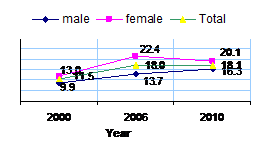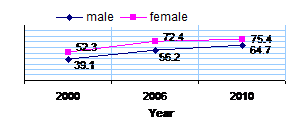The Palestinian Central Bureau of Statistics (PCBS)
Issues A Press Release on the Eve of the World Health Day (April 7th , 2013)
Ssecondary and Primary Health Care
In 2011, there were 81 governmental and non-governmental hospitals in Palestine, 25 of them are a governmental hospitals, while 56 are non-governmental hospitals with a capacity of 5,414 beds. On the other hand, 748 clinics and health centers are permeated over Palestine, 669 in West Bank, and 147 in Gaza Strip. It should be mentioned that, 68.5 of those clinics are adminstered by govermental sector.
Public Health
Population Aged 18 Years and Above with Chronic Diseases, 2000, 2006, 2010

In 2010, 70.7% of the elderly aged 60 years and over in Palestine suffered from at least one chronic disease: 71.6 % in West Bank compared to 68.7 % in Gaza Strip. The percentage was 46.5% in Palestine in 2000.
Prevalence of Chronic Diseases among Elderly by Sex, 2000, 2006, 2010

Smoking data shows that in 2010, 22.3 % of persons aged 18 years and above in Palestine are reported as smokers. 41.9% among males compared to 2.3% among females, the highest percentage was 32.9% in Ramallah and Al-Bireh. and the lowest percentage was 11.2% in North Gaza The percentage was 27.5% in Palestine in 2000.
Prevalence of Smoking among Youth Aged 15-29 years by Sex and region, 2010
|
Gaza Strip |
West Bank |
Palestine Territory |
Sex |
|
14.3 |
37.4 |
28.7 |
Male |
|
0.1 |
1.4 |
0.9 |
Female |
Fertility rates
The Fertility rate was calculated at 4.4 births per woman in Palestine, compared to 5.9 births per woman in year 2000.
Child and Infant Mortality rates
The mortality rate among those under five years of age is 23.4 per 1000 live births in Palestine: 21.0 per 1000 live births in West Bank and 26.8 in Gaza Strip. The rate in Palestine declined by 18.5% from 28.7 per 1000 live births in 2000.
The infant mortality rate in 2010 was calculated at 18.9 per 1000 live births in Palestine: 18.1 per 1000 live births in West Bank and 20.1 in Gaza Strip. The infant mortality rate in 2000 was 25.5 per 1000 live births and had declined by 25.9% since that date.
Underweight, stunted and wasted children under five years
In 2010, 3.7% of live births were underweight in 2010 The highest percentage was in Hebron 5.7%, compared to 2.5% in 2000.
10.9 % of under-5 years children in Palestine were stunted. The highest percentage was in Jericho and Al-Aghwar 16.8%, compared to 7.5% in 2000.
3.3% of under-5 years children in Palestine were wasted. The highest percentage was in North Gaza 6.9%, compared to 1.4% in 2000,
Increase in Use of Iodized Salt
In 2010, 76.6% of households in Palestine consumed adequate iodized salt: 68.1% in the West Bank and 90.7% in the Gaza Strip.
Reproductive Health
Anti-natal care
In 2010, 94.0% of married women aged 15-49 in Palestine reported receiving health care (4 visits at least) from qualified personnel during their last pregnancy: 92.7% in West Bank and 95.7% in the Gaza Strip.
Unsafe deliveries
In 2010, 0.8% of deliveries in the Palestine occurred at home; 1.2% in West Bank compared to 0.3% in Gaza Strip. The highest reports of unsafe deliveries were reported in Tubas governorate at 4.3 %, while the percentage was 5.2% in the Palestine in 2000.
Post-natal care
In 2010, 38.5% of married women aged 15-49 in Palestine reported receiving post-natal care: 42.4% in the West Bank and 33.2% in the Gaza Strip. The highest level of post-natal care was reported in the Jerusalem governorate at 64.5%.
Early marriage
Data indicated that the proportion of women in the age group of 15-49 years were married before the age of 15 years and amounted to about 4.6% in Palestine, where the percentage in West Bank was 4.4% and in Gaza Strip was 4.8%, and the percentage of women who married before the age of 18 years was about 35.5% with a rise in Gaza Strip by about 37.6%, compared with 34.3% in West Bank
Using of family planning
In 2010, 52.5 % of married women aged 15-49 years in Palestine use a family planning method; 55.1 % in West Bank compared to 48.2 % in Gaza Strip, While the percentage was 51.4% in Palestine in 2000.
Unmet need
15.6% of married women had unmet need for contraceptives among Palestinian women in Palestine, the highest percentage was in Hebron at 22.1% and the lowest percentage was in Bethlehem at 8.3%.
Cesarean deliveries
In 2010, 16.7% of reported deliveries in Palestine were reported as cesarean section deliveries. 18.6 % in West Bank compared to 14.0% in Gaza Strip. The highest percentage of cesarean deliveries was reported in Tubas governorate with 35.5 % while the lowest was in Hebron governorate with 10.4 %, while the percentage was 8.8% in Palestine in 2000.
 عربي
عربي